List of town halls in Thuringia
This list collects the town halls of the cities in Thuringia .
introduction
The first town halls were built in Thuringia at the beginning of the 12th century with the emergence of municipal self-government. Very few town halls from medieval times have survived in their former form, but many younger town halls are built on foundations from the Middle Ages. Examples of medieval town halls have been preserved in Jena as stone buildings and in Waltershausen as half-timbered buildings.
During the Renaissance , new town hall buildings were built across the country, including in smaller country towns. Due to frequent city fires, they were often rebuilt or rebuilt. This development continued into the early 19th century. Significant Renaissance town hall buildings can be found in Gera, Gotha and Altenburg, for example.
With industrialization, many cities grew to many times their previous size, which is why there was an increased space requirement for administration and increased urban self-confidence. This resulted in large-scale new town hall buildings, such as those in Zeulenroda and later in Erfurt and Weimar. This development came to an end with the new building of the Sonneberg town hall in 1928. Later, rather individual departments from the town halls were outsourced to other functional buildings when there was no more space, instead of building representative new buildings. Extensions from the 19th and early 20th centuries can also be found in many places.
In the period that followed, very few new town halls were built. With the rising awareness of monument protection , the renovation of the town hall buildings began. After reunification in 1990, this development accelerated, so that almost all town halls in Thuringia have been renovated since then.
list
| city | construction time | style | description | image |
|---|---|---|---|---|
|
Altenburg ( Article ) |
1561 to 1564 | Renaissance | built by Nikolaus Gromann |

|
|
Apolda ( Article ) |
1558/1559 | Renaissance |

|
|
| Arnstadt | 1582 to 1586 | Renaissance | built by Christoph Junghans |

|
| Artern | 1906 | Neo-baroque | 1905 to 1906 built on the site of the old town hall, a former department store from the 14th century |

|
| Auma | 1793 1907/1908 |
Neo renaissance | 1556–1557 Construction of the town hall using the existing foundation walls of a previous building, 1792–1793 reconstruction of the town hall and the town church after a town fire, 1907/08 start of construction and inauguration of the new town hall |

|
| Bad Berka | after 1816 | classicism | built after a city fire by Clemens Wenzeslaus Coudray as part of the market square ensemble |

|
| Bad Blankenburg | around 1750 | Baroque | rebuilt after the fire of 1744 |
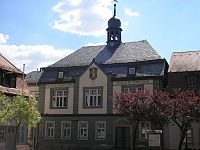
|
| Bad Frankenhausen | 1833/1834 | classicism |

|
|
| Bad Köstritz | End of 17th century | Baroque | Former princely palace, today the seat of the city administration |

|
| Bad Langensalza | 1742 to 1751 | Baroque | rebuilt after the city fire of 1711 |

|
| Bad Liebenstein | around 1850 | Neo-renaissance | Former educational center and country rest home for boys |

|
| Bad Lobenstein | historicism | A figure, the "Lommesteener Fässleseecher", can be seen in the clock tower several times a day. |

|
|
| bad Salzungen | 1790 | Baroque |
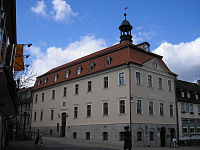
|
|
| Bad Sulza | 1541/1727 | Renaissance | after a fire in 1727, rebuilt in different ways |

|
| Bad Tennstedt | 1598 | Renaissance |

|
|
| Berga / Elster | 1844 | historicism | Reopened to traffic on May 1, 1844 after a fire in 1842 |

|
| Berka / Werra | 1667 | Renaissance | After destruction in the Thirty Years' War rebuilt |

|
| Blankenhain | Baroque |

|
||
| Bleicherode | 1540/1541 | Renaissance |

|
|
| Brotterode | 1895 | historicism |

|
|
| Bürgel | classicism |

|
||
| Buttelstedt | classicism |
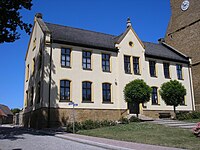
|
||
| Buttstädt | 1501 to 1606 | Renaissance | The east wing was built in 1501, the south wing in 1565 and the north wing from 1604 to 1606 according to plans by Christophorus German . |

|
| Camburg | 1888 to 1890 | Neo-renaissance |

|
|
| Clings | 1856 | historicism |

|
|
| Creuzburg | 1589 | Renaissance | Reconstruction of the old town hall, which was used as a Latin school in the meantime, after its destruction in World War II , on April 1, 1945 by US artillery bombardment; the new town hall from 1825 was also completely destroyed and not rebuilt. |

|
| Dingelstädt | Neo-renaissance |

|
||
| Dornburg | 1717 | Baroque |

|
|
| Life | around 1950 | Neoclassicism |

|
|
| Ebersdorf | Biedermeier |

|
||
|
Eisenach ( article ) |
1564 to 1641 | Renaissance |

|
|
| Eisenberg | 1579 to 1593 | Renaissance |

|
|
| Ice field | 1836 | Biedermeier | Rebuilt after a city fire in 1822. The three-storey building has a round entrance portal, above which there is a coat of arms relief carved from sandstone from 1557. |
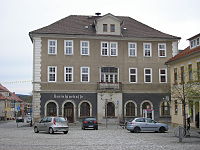
|
| Ellrich | 1879 | Functional building | In 1879 the current town hall, the prison (back building) and the district court were housed in a former warehouse in Salzstrasse. |

|
|
Erfurt ( Article ) |
1869 to 1882 | Neo-Gothic | built by Theodor Sommer . Extensive expansion by Johannes Klass from 1933. |
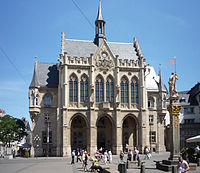
|
| Friedrichroda | Home style | Destruction of a town hall by a large fire in 1634 |

|
|
| Gebesee | 1806 | classicism | Inaugurated on June 21, 1806 as the successor to the town hall from 1540 |

|
| Fell | 1860 | historicism | last rebuilt in 1860 |

|
| Miter | Baroque |

|
||
| Geisa | 1859 to 1861 | Neo-Gothic | Erected after a city fire in 1858 on the square of the old town hall on the southeast corner of the market square |

|
|
Gera ( Article ) |
1573 to 1575 | Renaissance | built by Nikolaus Gromann |

|
| Goessnitz | classicism |

|
||
| Gotha | 1566 to 1574 | Renaissance | The old Gotha town hall was built as a department store and used as a town hall from 1665. |

|
| Graefenthal | 1874 to 1876 | classicism | rebuilt after a fire accident |
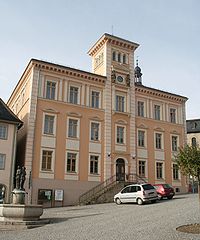
|
| Greiz | 1840 to 1842 | Neo-Gothic | The old town hall fell victim to a city fire in 1802. The current building was rebuilt between 1840–1842 and an extension was added in 1909. |
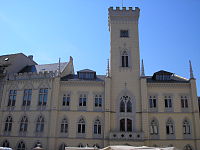
|
| Greetings | 1834 | classicism | The free-standing town hall burned down completely in 1491 and 1687. In 1834 the surrounding walls remained standing after the fire and formed the basis for the reconstruction. |

|
| Großbreitenbach | 1615 | Baroque | Slated half-timbering, expansion of the town hall in 1615 proven in a deed of purchase |
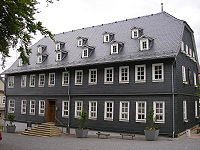
|
| Great, really | 1831 | Neo-renaissance |

|
|
| Heiligenstadt | after 1739 | Baroque | built by Johann Christoph Heinemann |

|
| Heldburg | Renaissance | Henneberg framework |

|
|
| Heroics | 1900 to 1901 | Neo-renaissance | built by Friedrich Fahro |

|
| Herrings | 16th century | Renaissance | The town hall experienced an eventful history of construction and use, from around 1970 to 1990 as a restaurant. A complete renovation took place in 2010. |
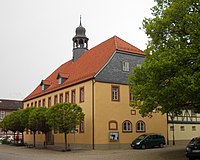
|
| Hermsdorf | 1896 to 1897 | Neo-renaissance | inaugurated on October 1, 1897 |

|
| Hildburghausen | 1595 | Renaissance | Probably the oldest building in the city was built in 1395 instead of a burned-down stone house as a council and department store, rebuilt in 1572 after being destroyed by a hurricane. |

|
| Hirschberg | Biedermeier |

|
||
| Hohenleuben | 1879 | Neoclassicism | built as a district court, used as town hall from 1919 |

|
| Ilmenau | 1768 to 1786 | Baroque | built by Gottfried Heinrich Krohne |

|
| Jena | 1377 to 1413 | Gothic |

|
|
| Kahla | 1872/1873 | historicism | The building is essentially Gothic in origin and has been rebuilt many times. In 1872/73 three neighboring buildings were included and the town hall got its present shape. |

|
| Kaltennordheim | 1884 | Neoclassicism | rebuilt after the fire in 1882 |

|
| Kindelbrück | 1761 | Baroque | rebuilt after a city fire |

|
| Koelleda | 1698 to 1702 | Baroque | Replaced a burnt down previous building as the third town hall |

|
| Koenigsee | 1719 | Baroque | The former tower clock, built by an unknown craftsman in 1710, is on display in the foyer. |

|
| Crane field | 1902 | Neo-renaissance | The town hall was built after a city fire and first housed the Weimarischer Hof before the mayor's office was moved here from the Ratskeller in 1917. |

|
| Langewiesen | 1935 | Neoclassicism |

|
|
| Lauscha | 1868 | historicism | former historical school building, the "new school"; slated half-timbered building |
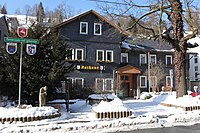
|
| Lehesten | Neo-renaissance |

|
||
| Leinefelde | historicism | The town hall is housed in a converted railway water tower. |

|
|
| People Mountain | 1866 | Neo-Gothic | rebuilt after a fire in 1865, the first town hall was named in 1486 |

|
| Lobeda | End of 17th century | Baroque | Half-timbered building instead of the building that was destroyed by fire in 1640. A town hall is attested to at the end of the 15th century, and the first previous building may have been destroyed in the middle of the 14th century. |
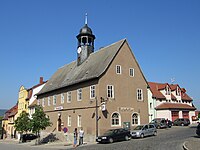
|
| Lucka | End of the 19th century | Neoclassicism | Historical Ratskeller 1972 due to Dilapidation blown up, today's town hall since the end of the 19th century |
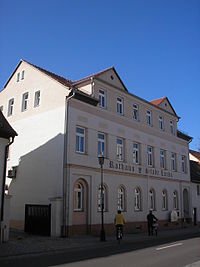
|
| Magdala | 1570/1571 | Renaissance | rebuilt after fire in 1849 |

|
| Meiningen | 1876 to 1878 | historicism | The town hall built by Otto Hoppe was destroyed in the Second World War and not rebuilt. Since then, the city administration has been housed in the rotunda of Elisabethenburg Palace. |

|
| Meuselwitz | 1861 to 1862 | Neo-Gothic | Inaugurated with the city charter on July 6, 1874 |

|
|
Mulhouse ( Article ) |
1256 to 1572 | Gothic Renaissance |
The town hall of the former free imperial city consists of several buildings, the oldest of which date from the 13th and the youngest from the 16th century. |

|
| Münchenbernsdorf | Early 20th century | Art Nouveau | Use as town hall since 1945 |

|
| Neuhaus am Rennweg | Functional building | Slated functional building, set up as a town hall after the Second World War. The 1933 town hall was destroyed on April 11, 1945 in an artillery attack by the 11th Panzer Division of the 3rd US Army. |

|
|
| Neumark | Renaissance |

|
||
|
Neustadt an der Orla ( Article ) |
until 1464 | Gothic | Created after 1464 through the union of two neighboring buildings |

|
| Nordhausen | 1608 to 1610 | Renaissance | The Roland figure on the town hall commemorates the overthrow of the council in 1375. |

|
| Oberhof | Neoclassicism |
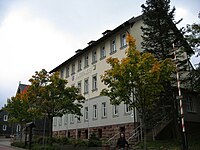
|
||
| Oberweißbach | 1856 | Historicism, modernized | Part of the district court building, built in 1831, opened on March 22, 1832, and an annex building was added in 1856. The seat of the administrative association Bergbahnregion / Schwarzatal is today housed in the neighboring administrative building from 1829. |
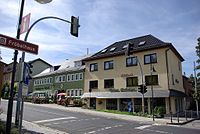
|
| Ohrdruf | 1808 | classicism | on the southeast corner of the "Iron Michael", an approximately 2.20 meter tall wooden figure from the workshop of the Ohrdrufer wood sculptor Hermann Schmidt from 1916 |

|
| Orlamünde | 1492 to 1502 | Gothic | 1864 neo-Gothic extension |

|
| Plaue | 1822 | historicism | 1856 Roof and upper storey badly damaged in a fire and rebuilt |

|
|
Pößneck ( article ) |
1478 to 1531 | Gothic | built by master builder Conradt |

|
| Ranis | 1839 to 1840 | Neo-renaissance | built as a school |

|
|
Rastenberg ( Article ) |
1663 | Renaissance | Built in 1565, burned down in 1663 and rebuilt in the same year in the same place |

|
| Remda | after 1945 | Baroque, modern rebuilt as a functional building | after destruction in World War II, by US artillery bombardment on April 13, 1945, rebuilt after the end of the war |

|
| Römhild | Renaissance |

|
||
| Ronneburg | 1529 | Renaissance | First mention of a town hall in 1476. According to a year on the south side, today's town hall was built in 1529, in 1665 the roof structure and woodwork were destroyed in a town fire and repaired again by 1674, last renovation in 1928/29. |

|
| Rossleben | historicism |

|
||
| Rudolstadt | 1908 to 1912 | Neo-renaissance | built by Theodor Veil and Gerhard Herms |

|
| Ruhla | historicism | After the old town hall was demolished in 1997, the city administration moved into a converted factory building. |

|
|
| Saalburg | historicism | built on medieval foundations |

|
|
|
Saalfeld ( article ) |
1529 to 1537 | Renaissance | probably built by master builder Krebs |

|
| Schalkau | 17th century | Baroque | Slate half-timbered building with hipped roof |

|
| Schkölen | historicism | former manor |

|
|
| Schleiz | 1879/1880 | Neo-renaissance | built by Richard Uebe |

|
| Schleusingen | 1550 | Renaissance | extensively rebuilt several times |

|
| Schlotheim | 1996 | postmodern functional building | Inaugurated on August 3, 1996 as a completely new building on the site where the 251-year-old town hall stood until 1972. In the history of Schlotheim, this is now the 5th town hall. |
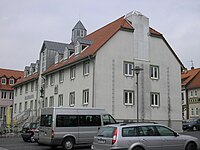
|
| Schmalkalden | 15th century | Gothic | Three architecturally completely different buildings form the town hall complex today: the southern building from 1905, the northern building with late Gothic components and the central building - the "stone bower" from 1419. |
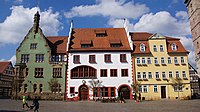
|
| Schmoelln | 1540 | Renaissance | rebuilt after fire in 1772 |

|
|
Sömmerda ( Article ) |
until 1539 | Renaissance | The town hall, which probably already existed in the 15th century, was extensively rebuilt between 1529 and 1539, an extension from 1554 was replaced by a new baroque building in 1725. |

|
| Sondershausen | 1568 to 1570 | classicism | Rebuilt in 1856 |

|
| Sonneberg | 1928 | Neo-Gothic / Neoclassicism | The old town hall had the town built in the neo-Gothic style in 1844/45 on the market square near the location of the 17th century town hall, which was destroyed in the town fire in 1840, according to plans by Carl Alexander Heideloff , and was rebuilt by Hermann Schuberth in 1886/87. In 1927/28 Karl Dröner built the New Town Hall on Bahnhofsplatz. |
 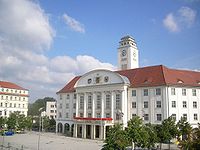
|
| Stadtilm | around 1600 | Renaissance | Castle, only used as town hall from 1918 |

|
| Stadtlengsfeld | 1878 | classicism | Today's town hall was built as the Grand Ducal Saxon District Court after the city fire in 1878 and was used as a courthouse until 1945. After the war it was a residential building and classrooms were set up at times. It was and is mayor's office since 1880. |

|
| Stadtroda | 20th century | Art Nouveau | first town hall destroyed in a town fire in 1638, second in bombing during the Second World War on November 21, 1944 |

|
| Steinach | 1948 | Neo-baroque | The three-story main building was created by combining the houses at Marktplatz 3 and 4, which were built between 1923 and 1924. |

|
| Steinbach-Hallenberg | 1900 | Home style | New town hall, laying of the foundation stone on March 26th, handover on October 1st, 1900 |
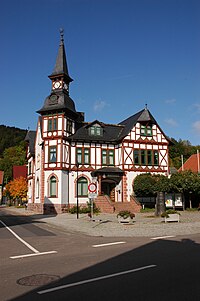
|
| Suhl | 1812 to 1817 | Neo-baroque | Facade rebuilt in 1913 |

|
| Tambach-Dietharz | 1919 | Neo-renaissance |

|
|
| Tanna | historicism |

|
||
| Teichel | 1863 to 1867 | Neo-Romanesque | built by Wilhelm Adolph von Bamberg |
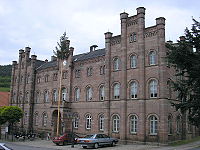
|
| Thamsbrück | Baroque |

|
||
| Themar | until 1711 | Baroque |
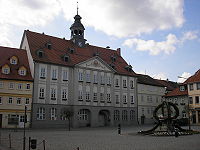
|
|
|
Treffurt ( article ) |
around 1550 | Renaissance | Tower added in 1616 |

|
| Instinct | around 1900 | Neo-renaissance |

|
|
| Triptis | Neo-renaissance |

|
||
| Truse Valley | Postmodern |

|
||
| Ummerstadt | 1558 | Renaissance | Henneberg framework |

|
| Vacha | 1613 to 1614 | Renaissance | was built in 1614 as a representative city palace of the Hessian bailiff Caspar von Widemarkt |
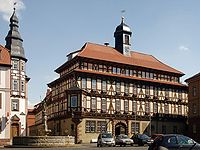
|
| Waltershausen | 1441 | Gothic |

|
|
| Wasungen | 1532 to 1534 | Renaissance | Henneberg framework |

|
| Weida | 1587 to 1589 | Renaissance |

|
|
|
Weimar ( article ) |
1837 to 1841 | Neo-Gothic | built by Heinrich Hess |

|
| Weissensee | 1200 to 1589 | Renaissance | The town hall consists of several parts of the building that have been repeatedly rebuilt and overbuilt. |

|
| Wiehe | historicism |

|
||
| Worbis | 1608 | Renaissance | former moated castle and rent office, northwest wing from 1608 |

|
| Wurzbach | Neo-renaissance |

|
||
| Zella Mehlis | 1924 - 25 | Neoclassicism | The town hall was built according to the plans of the architect and ducal building director Reinhard Claaßen, Coburg. Construction began on May 19, 1924 and the opening on August 22, 1925. |

|
| Zeulenroda | 1825 to 1827 | classicism | built by Christian Heinrich Schopper |

|
| Ziegenrück | 16th century | Renaissance |

|
literature
- Georg Dehio : Handbook of the German art monuments Thuringia . Deutscher Kunstverlag, Munich 2003, ISBN 3-422-03095-6 .